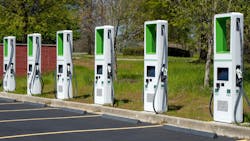Measured by the intensity of media interest, it would seem the automotive world is in the midst of an electric vehicle (EV) boom. However, some recent research has caught my attention because it tells a much different and nuanced story pointing toward a "build it and they will come" mentality.
A recent J.D. Power & Associates survey highlights an absence of consumer interest in EVs and self-driving technologies. "Right now, there are about 50 [EV] models scheduled for a U.S. debut by the end of 2022. In that same two-year period, only 13% of the consumers we polled expect to buy one while 30% stated they have no intention to ever consider buying one."
Additionally, according to a survey by Blastpoint, the consumers who are planning to buy an EV share definite demographic traits such as high incomes, college degrees, homeownership, and ownership of multiple vehicles already.
Another common opinion is that the commercial electric vehicle segment of the market, or CEVs, leads this enthusiastic transformation, moving from internal combustion engines to trucks powered by batteries or hydrogen fuel cells. However, a proprietary survey conducted by, our sister brand, the Endeavor Business Media Commercial Vehicle group also tells a different story. Despite public enthusiasm for electrification technology, only a few fleets are beginning to explore CEV adoption with limited pilots that are just getting underway. Commercial electric vehicles have found some early adopters among U.S. fleets, but the numbers are small, and most are in the pilot and testing phase. And, whether they be for-hire carriers or private fleets, the vast majority of those operating trucks are waiting on the sidelines, measuring potential benefits against several significant barriers or concerns.
In totality, this research indicates that automakers need to figure out how to get more people into electric vehicles to increase consideration. Some help may be on the way in the form of a federal infrastructure plan.
Infrastructure Plan
The Biden Infrastructure Plan is a national effort to create millions of jobs, build modern and sustainable infrastructure, and deliver a clean energy future. One of the means proposed to support the grid of the future is to remove barriers to the use of EVs, including concerns about price, range, and access to charging stations.
The Biden Administration proposes working with utilities to install advanced metering equipment and deploy EV charging infrastructure. Other key aspects of the plan are as follows:
- Build a national electric charging system of 500,000 public charging outlets so that Americans can drive anywhere in the United States in an EV by 2030.
- Help state and local governments plan for the widespread adoption of EVs.
- Restoring the electric vehicle tax credit and incentivizing businesses to shift their fleets to EVs. Additionally, President Biden says that he will ensure that the U.S. Department of Energy invests $5 billion over five years in battery and energy storage technology to boost the range and slash the price of electric cars.
- The U.S. Department of Transportation will also provide an additional $1 billion per year in grants to ensure certified technicians install the charging stations.
- Convene the U.S. Departments of Energy and Transportation to coordinate on special demonstration projects, e.g., testing new highways that can charge EVs while in transit and pilot projects that use EVs as mobile energy storage units. The Departments will provide grants to cities, towns, and counties that are open to piloting new charging infrastructure.
- Enact policies to promote domestic manufacturing of EVs.
- Workforce training like the Electric Vehicle Infrastructure Training Program (EVITP).
Build It and They Will Come?
Given these research findings, I'm concerned that the industry may be pursuing a build-it and they will come approach to electric vehicle infrastructure. And, while EVs with Vehicle-to-Grid (V2G) technologies can potentially deliver grid and customer benefits, the use of V2G capabilities is still in its infancy.
As taxpayers and ratepayers, it is prudent that we take a hard look at whether consumers are even interested in adopting these technologies. Additionally, we must scrutinize whether these EVs will be used as a bidirectional grid resource to benefit all customers. As more utilities invest ratepayer funds to support and expand electric vehicle charging, we also need to ensure that the collective doesn’t bear an undue burden of funding infrastructure only used by a subset of affluent or urban vehicle owners.
Until next time, stay safe and healthy!
About the Author
Martha Davis
Senior Director of Content
Prior to working at T&D World and Utility Analytics Institute, Martha worked as an executive in the energy industry for about 15 years. She has held various regulatory and government affairs positions and had the opportunity to shape public policy.
Martha has a B.A. from Westminster College in Fulton, MO; completed specialized legal and public policy coursework at American University in Washington, D.C.; M.P.A. Public Affairs and M.B.A. Business Administration both from the University of Missouri. She is currently a doctoral candidate at the University of Denver where she is researching business analytics, innovation and regulation.
